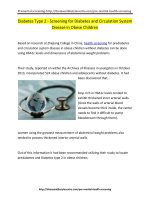Equation tutor for sighted and visually impaired children
Bạn đang xem bản rút gọn của tài liệu. Xem và tải ngay bản đầy đủ của tài liệu tại đây (462.12 KB, 15 trang )
AAFG 2005
Math-Puzzle:
Equation Tutor for Sighted and
Visually-Impaired Children
Jarno Jokinen
Department of Computer Sciences
University of Tampere Finland
April, 2005
Math-Puzzle
introduction
• communication of mathematics is usually visual
• formulas, diagrams, graphs etc.
• it is very difficult for blind and partially sighted people /
students to do mathematics and is one of the biggest
obstacles for them in school and at the university
Math-Puzzle
most of the work reported in developing techniques that deal with
mathematics can be presented through next categories:
• tactile as in Braille and other raised representations
• haptic or forced feedback devices represent shapes and curves
• tonal representing equations and graphs (sonification / audification)
• audio aids that read equations with tools to help in reading process
• integrated /multimodal approaches
Math-Puzzle
Introduction into the games
/>
/>
Math-Puzzle
/>
Math-Puzzle
project impetus
• created a game instead of making tests with an existing game
• mathematical game for blind children
• after different ideas, Math-Puzzle was chosen
• training in logics, memory and equations’ manipulation strategy
Math-Puzzle
the problems in question
• is it possible to solve equations using only short speech cues?
• what are the limitations?
• what is the easy way for blind interaction to edit the equations in
static or dynamical puzzle? (memory capacity or external memory aid
see next slide)
• how long does it take to solve a puzzle?
• what are the parameters of the gameplay progress and player
performance?
• how much does it make difference when player has visual feedback
or all the tasks (including navigation within the game-field) are
presented through sounds?
• how and in which order the equations could be solved? (strategies)
Math-Puzzle
different matrix approaches
• static puzzle on the left
• dynamic puzzle on the right
Math-Puzzle
game concept
• 5x5 matrix with one equation in each row
• equations are predefined and randomly picked for the matrix
• the goal of the game is to change the places of the equation members
so that all of the equations are true
• the figures (only in the same column) can be swapped by clicking one
number and then the other one
• operators cannot be swapped as well
other controls are:
• alt+R -> new game (reset)
• alt+M -> minimize / maximize browser window
• alt+S -> show / hide figures and operators
• the puzzle completion time and the number of moves are calculated
• the game is currently implemented only in www with limitations
Math-Puzzle
testing procedure
• 5 technically aware adults (age ranged from 26 to 34)
• 10 games per player with all three playing modes:
1st visual, 2nd blind (hidden labels with sound cues), 3rd blindfolded
• laptop pc with external mouse and headphones
Math-Puzzle
problems
• sound feedback is not supported with
mozilla browsers
•
completing
the
fourth
equation
usually completes also the fifth
• if not, the answers are crossing each
other in a way that makes it very
difficult to solve the puzzle
• the program sometimes gives 1 or
more correct equations at the start
which may also result in an error on
the browser
Math-Puzzle
results and discussions
• the game (blind mode) is hard for adults that can see
• what about kids that can’t? They have better spatial understanding
• some matrixes can be a lot faster solved than others – repetitions
needed for a good estimate of skills
• if you wan’t to hear the sound cues you need to be patient
• sound is heard when the mouse is moved over the square, so if you
want to hear it again you must move the mouse away and over again
• completing the fourth equation is crucial as explained on next slide
Math-Puzzle
about the fourth equation
OK
OK
OK
OK
Math-Puzzle
conclusions
• game requires a lot of memorizing, but there are strategies that help
• completing equations in some order
• using mathematical rules (division and multiplication)
• when playing the game blindfolded, the increase in speed was bigger
than when playing the visual version
Math-Puzzle
References
/> /> />Children’s math project /> />Lambda-project: Linear Access to Mathematic for Braille Device and Audio-synthesis
/>Karshmer, A.I., Gupta, G., Gillan, D. Architecting an Auditory Browser for Navigating Mathematical
Expressions, ICCHP 2002, LNCS 2398, p. 477
/>Gaura, P. REMathEx - Reader and Editor of the Mathematical Expressions for Blind Students, 2002,
LNCS 2398, p. 486, />Fitzpatrick D. Speaking Technical Documents: Using Prosody to Convey Textual and Mathematical
Material, ICCHP 2002, LNCS 2398, p. 494,
/> />Math project, />Prosody in Mathtalk />Mathematical Access for Technology and Science,
/>Edwards, A. D. N., Stevens, R. D. and Pitt, I. J. Représentation non visuelle des mathématiques,
(translated by A. Assimacopoulos) in A. B. Safran and A. Assimacopoulos (editors) Le Déficit Visuel,
Éditions Masson, pp. 169–178 (1995),
/>Karshmer, A.I., Gupta, G., Geiger, S., and Weaver, C.: Reading and Writing Mathematics: The
MAVIS Project, BIT (Behaviour & Information Technology), January 1999









